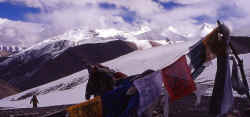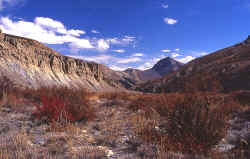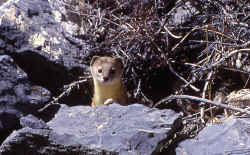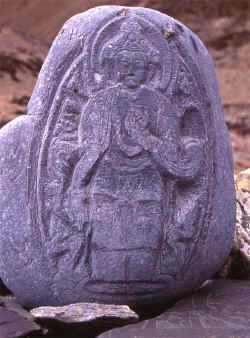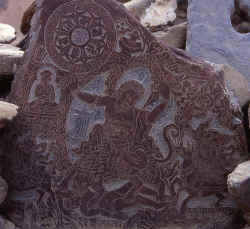MyHimalayasimpressions from |
|
|||||||
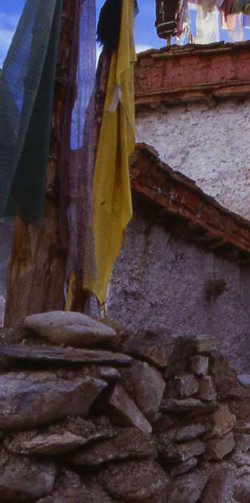
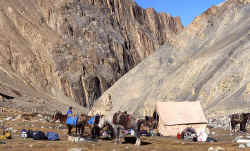
Morning in Tahungtse, horses are being loaded for a long day.
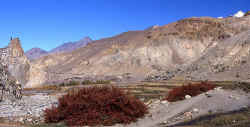
Valley of Hankar, a beautiful hamlet. The old fort is dilapidated but the tower
on top of the natural rock pillar still watches over the town and the terraced
fields.
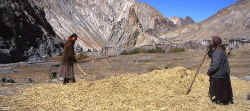
Women are finishing harvesting, their traditional whistling can be heard from a
long distance.
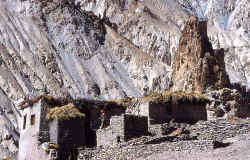
Houses and fortress in Hankar.
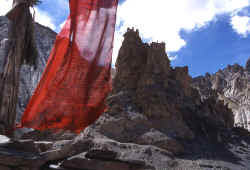
From the monastery at the town's end we see the remains of the old fortress.
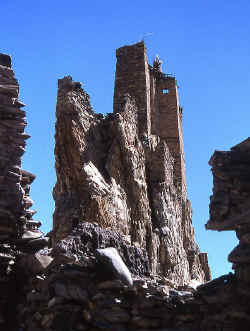
The tower of Hankar dzong is still in good condition and the prayerflag on top
is exchanged every year.
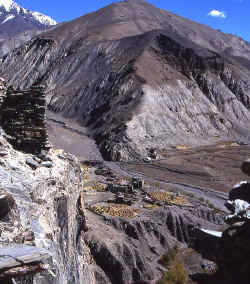
View from the foot of the tower down to the village
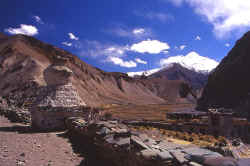
Kang Yaze forms the background, people in the village have collected the barley.
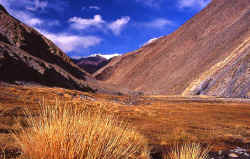
We continue to follow the river xxx to reach the base of our second pass. The
evening sun illuminates and increases the natural play of colours.
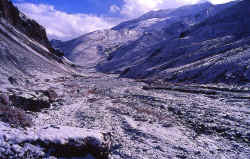
Fairytale scenery on our way to the pass.
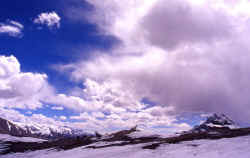
Approaching the prayerflags that mark the top of the pass Zalung Karpo La.
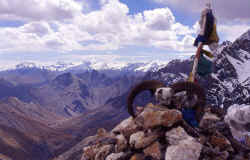
The view from the pass southwards to Sorra and the ancient fort of Karnak.
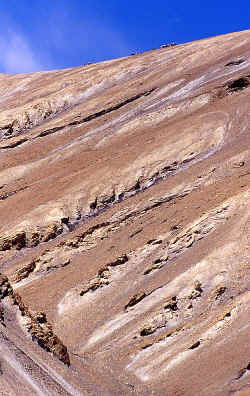
The southern slope of the Zalung Karpo La is completely free of snow
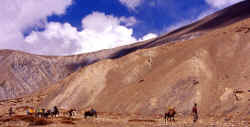
Sorra valley is quite a different world than the valley to the north of the
pass.
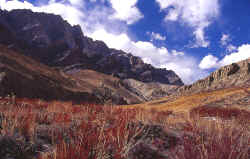
Colourfull valley of Sorra in the afternoon sun.
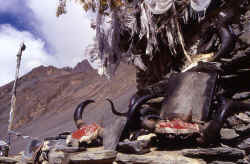
Lhatso, a solemn spot where villagers from Dat make offerings to the local
mountain deity. The goddess lives on the pyramid shaped summit.
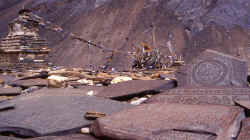
A huge number of mani stones with inscribed mantras are piled around the
lhatso.
Tso Moriri: Tahungtse - Zalung Karpo La - Dat
Tahungtse - Zalung Karpo La - Dat
Tahungtse – Zalung Karpo La Base (Day 8)
I wake up early and have to force myself not to get up too early, skip breakfast and walk to the next village. Breakfast is too important. The horses grazed very nearby, making it easy for Tenba to drive them into a group and tether their feet to load them.
The way out of the valley goes between two walls of vertical rock layers. The creek takes a sharp right bend where we cross it on a nicely built wooden bridge. Ahead lie the distorted ranges of Zanskar, opposite some gentler mountains with snowy peaks. A large eagle ‚sails‘ along the ridge, covering a large distance without moving its wings a single time. It’s a lovely valley with a creek running at the bottom of the vertical cliffs. The trail runs on its other side where colourful bushes seem to act like border guards between the Zanskar cliffs and the more open Ladakhi landscape. Fields cover the few spots that are a little wider; people live a harsh life and have to use every cultivable spot that the mountains offer, no matter how tiny it is. Unwatched yaks and donkeys graze on the harvested fields. Another narrow passage lies ahead before we enter the wider valley of the Hankar.
A small irrigation channel branches off to the right, indicating a larger settlement at its end further down. An isolated tall rock resembling a gigantic stalagmite looms over the village with a tower built on top. It’s almost impossible to notice, first because you wouldn’t expect a building on such an exposed spot, and secondly because it blends in so perfectly.
The wind carries the sound of people singing and whistling towards us. A minute later we are at a thrashplace in front of Hankar. The barley was cut from the fields and is now flailed. Two women throw the piles in the air, the wind blows the sheaves away. The fascination of harvest scenes is hard to describe, it might be the simplicity of rural life that appeals to bored and stressed westerners, but hopefully it is more than that. Maybe it is the subtle presence of people, their will to live in these stark surroundings. The human presence does not decrease the wilderness; instead it emphasises the beauty of nature. And it is heart-warming to see the satisfaction of the people, the pleasure they find in their daily life – of course they do face many hardships and sorrows, but this is harder to detect.
The village consists of a dozen houses, the characteristic white-wash is gone due to the increasing rain in summer. The architecture is less identical than usual, some houses are simple and two-storied, others have ladders going to the roof on which the storeroom and living quarters are. We stop at the first house and walk up the staircase to the roof. A young couple shows us their house, especially the meticulously clean living room that also serves as a kitchen. The iron hearth stands in the middle of the room, near the window are some benches with thick carpets. A cupboard above the fireplace contains the kitchen utensils, apparently this is the housewife's pride. Polished pots, cups, ladles and spoons are neatly arranged like in a museum. Though this is not a regular shop we go on a shopping frenzy. Kitchen utensils, pots, bowls and rupees change hands and everybody is happy in the end.
A single wooden pillar supports the ceiling, at the upper end are butter paintings of the 8 auspicious symbols of Buddhism. I've read somewhere that the butter turns into a natural form of penicillin after some months, but I don't know if that's true, and if it were, if people know this and use it as medicine.
Above the fireplace is a second cupboard with a few clay figures of animals like frogs, horses, goats. Usually they are created during Losar, the Tibetan New Year in February. In other ceremonies I have seen that clay figure are used to 'unload' all the evil and cast it onto the effigy, afterwards it is carried out of the house and put down on a crossroad. This must be a completely different custom, maybe the Ladakhi have an opposite ceremony, in addition to getting rid of evil they might have another one to bring the 'good' into their house.
A separate building on the rooftop is used as a storeroom where bags of barley and - sewn into a yak hide – chunks of butter are kept. In a warm south-facing room stands a large basket filled with blankets, the housewife proudly shows the 'content', her two-month old baby. She takes the basket with her when she goes out, the little boy peeping out between the blankets.
Hankar lies in the Markha valley, probably the most popular trekking route in Ladakh that sees 1'000 trekkers a year, most of them in summer. Now that the tourists are gone, the village appears unaffected my modern times. A fortress overlooks the valley from the top of a crag, like a natural extension. Attackers hundreds of years ago must have thought: "Wow, the guy who had this built up there is somebody I don't want to mess with." The trail is chiselled in the sheer rock and obviously still in use. Only the very top and the tower are visible from below, when we reach the top of the hill we are surprised by the size of the entire compound. Dozens of houses - now dilapidated - formed a village much larger than Hankar itself. Whether it was destroyed by Dogra invaders who conquered the area in the middle of the 19th century, or fell into ruins because its inhabitants left remains a mystery. The tower must still fulfil a function, prayerflags flatter in the wind and though it is unlikely that it's the seat of a local deity, villagers might think of it as a form of protection against possible mishaps like storms, droughts, or disease. Putting up the prayerflags looks like a task for the bravest villager. Getting to the base requires some rock climbing, but then up the narrow stairs inside the tower proves too adventurous for me.
The views are stunning again: People are working on the yellow bushels of barley. The village lies peacefully between the fields in the valley with a stupendous wall on the one side and barren hills on the other. A little creek shines silvery in the sun and Kang Yaze majestically overlooks the whole scene. In the opposite direction down the valley is a forest with trees of different colour, quite a contrast to the endless repetition of bizarre rock formations.
The monastery is a simple square building at the outskirts of the village, nobody is there and I cannot find the keeper of the key. Nevertheless, it is a fine place to sit down in the shade and admire the village and its fortress. The tower is a reminder of a great past, though it seems that the villagers today have a solid future based on a sensible combination of farming and tourism.
Leaving the pleasant village behind is hard; a two-day stay would be a nice way to learn more about Ladakh and its people. But we have been lucky enough to get a good glimpse, and it's time to leave. A number of passes lie ahead of us on the way to Tso Moriri. Tomorrow we should cross Zalung Karpo La. To make it a little easier, setting camp as high up as possible is a good idea and we’ll have to walk late into the afternoon to get there.
After a short walk in the fantastic canyon along the river Langtang Chu we cross it once and have lunch on a wide plateau. The shallow creek flows in long gentle curves from one side of the valley to the other, forcing us to either wade through or jump across it. We pass many sidevalleys and slowly the snow peaks above Hankar get smaller and smaller. Suddenly I hear rockfall, caused by blue sheep that have descended to feed on grass along the river. I get to the opposite bank when they decide that I got too close, and calmly retrace their steps up the mountain.
The way to camp is long. Very long. The scenery is stunning at first and captivates all senses, but after hours of walking my legs get heavier and heavier, and after the sun has sunk early behind the ridge a cold wind starts blowing up the valley. After every curve I expect to see our horses grazing on the dry yellow grass, with our tents already put up in the background. Another curve. I pass more mani walls without catching sight of the camp. Another curve. I'm weary, but luckily everything else is ok - the weather is fine, I'm in good health and the scenery stunning. Yet the wish to relax comfortably at camp is bigger than the pleasure of walking. Another curve. Then, finally, in the middle of a wider valley I see the horses and a little later the kitchen tent.
After putting up the tent and settling in it's already time to get out the warm clothes. Dusk sets in, and no sign of Bob and Joel yet. Bob was not feeling well yesterday and slowed down before lunch today. Lobsang takes a horse and rides back to see what kind of help they need. He returns soon afterwards, grabs some food and sets out again. More than one hour later it is pitch dark, and they haven't arrived yet. While waiting for them, the cosiest and most interesting place is in the kitchen tent, Tenba speaks good English and is outgoing, Phuntsok is a little shy.
Finally we see a flashlight coming closer, but instead of Bob it's the 'independent' woman from Australia. She couldn't find a horse and guide going to Zanskar, has changed her plan and follows us instead. In a day she will give up carrying her heavy backpack and stay in the horsemen's tent. She doesn’t talk to us, we don’t talk to her – she is a strange travel ‘companion’.
Eventually two other lights come up from the valley, Bob has light bronchitis and is terribly exhausted, but otherwise fine. He sits outside his tent, enjoys the hot soup, and will hopefully get some rest tonight.
Zalung Karpo La Base Restday (Day 9)
We’re not crossing the pass today. Instead it’s a restday, mainly to let Bob recover and see how he feels in the evening. Tomorrow he has to decide whether to cross the pass or head back to Leh.
I can't sleep in and am up early, but too lazy to go for long walks. Kang Yaze looks easy to climb from this side, but it's definitely not a stroll up there. Hunting for blue sheep with binoculars would be interesting, but there don't seem to be any in this part of the valley. And going back to Hankar is a long way. So I stay at camp, read a little and enjoy the rest day.
Wind starts to pick up and by noon a cloudcover comes over the pass. Rest days with nice weather are great, but when it's not that warm the alternative of spending hours in the sleeping bag with some snacks and a book is equally fine.
Dinner is the highlight of the day, soon after finishing my three plates I'm back in my tent to escape the freezing temperatures.
Zalung Karpo La - Sorra (Day 10)
It was cloudy when I went to bed, some hours later in the middle of the night the stars shine brightly. Assuming that the bad weather has moved on towards Zanskar, I open the tent at 600 expecting a bright morning - only to find an inch of snow on the ground. Though it does look enchanting, it is an unpleasant surprise because walking will be more difficult, especially for the horses if there is more snow higher up. Hopefully the pass will be crossable.
Shortly before breakfast the fog lifts. The clouds are blown apart and reveal fantastic winter scenery. A thin layer of snow covers all but the steepest crags, the last layers of fog lie in the valley and the blue sky appears above us. The air has a stunning fresh smell. The snow crunches under my boots when we start, and though the sound usually indicates very low temperatures (at home) thanks to the strong sun I only wear a thin fleece sweater. Like yesterday, we continue up the along the river; but the whole atmosphere is completely different. The snowed in landscape appears like a scene from a fairytale.
The creek partly froze at night; water gurgles between the white boulders and disappears below the black ice. Thin branches of bushes and structure of yellow grass are accentuated by the snow that sparkles in the light. Sadly, the sun gets stronger and turns the fine flakes into drops of water.
We walk on the barren pebbles in the riverbed now. The river branches, and we continue our tough walk stumbling over the rocks. When we leave the river and start to climb on a small trail, there is no sight of the pass to guide us. Each of the surrounding hills could be the pass, and then finally the actual ridge gently rises ahead of us.
I expect to be at the top in half an hour - but it's a 'false pass'. There's nothing to be done except going on. My legs feel heavy and tired which is unusual, maybe the rest day wasn't good for my muscles. We walk on a snowfield, and reach the second false pass. The sky is partly covered by black clouds, partly blue and the battle between the two continues as we follow horse tracks and climb higher on a gentle slope. Then we see prayerflags on the horizon, a few steps later I'm finally on the Zalung Karpo La, 5'120 m. I stare in awe for a few seconds. The whole world - which at the moment consists of Zanskar and Ladakh - lies to my feet. An immense landscape opens up; snow-capped mountains, barren rockfaces, arid hills and deep gorges. The threatening clouds in the sky increase the feeling of vastness, they float in the blue sky like wanderers without a destination. A long ridge with several peaks dominates the left, to the right the view towards Zanskar is both beautiful and intimidating. A storm is building up over the canyons, though even in nice weather the canyons seem hostile and devoid of life.
In comparison, our route seems easy. We see for dozens miles, far at the horizon is the Mentok range near Tso Moriri, the end of our trek which we will reach in ten days. Luckily we cannot see any details, so no thoughts of the ending enter my mind. Finally my fingers hurt too much from the cold (operating Nikon F65 with gloves is impossible), and since everybody arrived and Bob was surprisingly fast, we start descending. Despite the freezing wind we stayed on the pass for a long time, taking pictures and admiring the scenery.
This side of the pass is completely free of snow. The trail zigzags down steeply and within half an hour we have lost all the hard-earned meters from the ascent. When it flattens out (relatively speaking), we stop at the first suitable lunch spot and wait for the others. As we rest and look up, the horses appear on the crest, tiny dark figures against the sky. Taking a break feels great, sitting down and stretching my legs is wonderful but I'm not very hungry. I've had lots of glucose and chocolate on the way up, while waiting on the pass I ate more biscuits and tofu sticks. I'm either full or too exhausted to enjoy the sandwiches today.
When the horses catch up with us, I follow them down the valley. It's very windy, therefore hot and cold at the same time. The horses take the upper trail, I descend to the river bed. A dark mountain, resembling a watchtower, looms above everything else, to the right are strange peaks of grey and white stones - lofty not because of their heights but because of the strange composition of vertical and horizontal crags and their colours. Vegetation increases as I descend in the washed out gully, the thorny red bushes and the little creek add colour and life to the canyon. For the second day, there is no sign of civilisation. It took me some time to get used to Ladakh, it is much wilder and rougher than Nepal, and somehow the stark scenery makes me feel tired more quickly than when walking through lush rice fields.
A meadow at the creek is a fine place to rest and a perfect site to camp. I lie on the grass, sun in my face, feet in the gurgling stream - but it is not quite hot enough to be totally comfortable. When the sun disappears, it gets chilly and when the horses arrive, we start putting up tents and put on warmer clothes instantly.
Sorra - Dat (Day 11)
As I fall asleep I hear strange noises on my tent, but don't bother to find out the cause: if it's snowing there is nothing I can do about it anyway. We get up early. The sun has risen but is hiding behind dark clouds already. Suddenly it clears, convincing me to start right after breakfast a little ahead of the others. I do enjoy company and woulnd't want to trek alone, but while walking I don't need company. I slowly stroll along the creek, stopping often and just looking around because the colours are brilliant this morning. The grass looks golden and the bushes bright red. Interesting clouds start building up, the wind changing their shape constantly. I scare up various small birds, and some rodents.
Further down in the valley are houses, all are empty and probably just used in summer. The creek feeding the irrigation channels has dried up some weeks ago, and people will only come back next spring. The creek we've been following since the pass disappears in a narrow gorge. On top of the some of the nearby peaks in lofty altitude are prayerflags that mark some special places as sights of protectors. The pre-Buddhist belief in local spirits and ghosts is still followed all over the Himalayas, maybe even stronger here.
On top of the black hill on the left stand two ruined buildings, the black silhouettes are barely noticeable. The fort controlled access to the valley, and gave the area its name: Karnak - Black Fortress. In earlier times there must have been either much more trade or the village at its foot must have been larger: the half dozen low stone shags does not seem worthy of a kingdom.
The valley suddenly makes a right turn and gets increasingly smaller, an impressive gorge which I enter with anticipation. Birch trees grow in the shade, the sun rarely reaches the valley floor. Even in the dry season it is a pretty scene, in spring or summer this must be even more enchanting.
Large holes puncture the rock cliffs above, some look like having been created by water but the ones hundreds of meters higher up must be the work of wind. In summer the crossing of the Karnak Chu is as difficult as beautiful, even now the creek is too wide and deep to jump across. Instead of wading through I accept Lobsang's offer to carry me across. We're at Tantse Sumdo where three valleys meet. To the northwest it goes to Zanskar, theoretically at least. It looks like a wild trail - if there even is one. It'd probably take a few days to reach the next village, and this sounds like an exciting destination for further exploration. [Back at home I looked at the map more closely: there is a trail from here to Phuktal gompa over the Shapodok La, 5’680 m high. A promising route, I have to talk to Joel about it.] Instead we head south, walking through an enchanting forest along the wide and deep creek that flows so quickly and straightforward that is seem more like a channel than a natural river. Dark clouds hang over Zanskar, and slowly the looming storm moves towards us. The scenery becomes surreal, the yellow grass - brightly lit by the sun - is contrasted sharply by the black clouds that move down and start hiding the crags. In the middle of another gorge we find a sheltered spot and prepare lunch. I shiver in the wind and snow starts to fall in tiny flakes. The contrast between the birch grove along river and the steep barren tall walls above it couldn’t be bigger. After some last minutes in the impressive canyon the scenery opens up and we enter a wide valley full of life.
Little ponds along the creek turn this valley into a fertile swampy plain. Half a dozen different kinds of small birds sit on bushes and rocks along the river. Above the valley walls a small bird of prey literally 'stands' completely still in the wind, then starts moving very slowly without clapping its wings. In a field of boulders ahead I thought I saw something move. I sit down and wait. Two minutes later a fistsized head peaks out between the rocks, watches curiously and eventually slips out of its hiding.
I spot the first butterflies in days, the small orange-winged insects are carried away by the wind. This is one of those days that you wish wouldn't end. I enjoy every single step, sight, sound and smell and let the horses and most of the group overtake me. They disappear far ahead where the plain enters another gorge. In summer people come here with their cattle, the round little stones walls on the dry land mark their tent places. The yak dung has not been picked up, an indication that people get their firewood from the forest? We cross the yellow plain and are soon back in another canyon.
In a widening of the valley a special site dominates the valley from a little elevation. A white-washed lhatso is the centre, the site is very large thanks to an enormous mani wall with thousands of carved stones. The actual place of worship is the lhatso that is decorated with juniper branches and strips of white cloth. The branches are symbolic and represent arrows. These arrows represent either the legendary hero Gesar or other powerful local mountain deities that have power and control over nature. In addition to please their mountain deity upon whose good-will depends so much the nomads have put coins in a little hole at the foot of the 'altar'. Next to it is a pile of dozens of yak skulls with horns to keep demons away; some are inscribed with mantras. Three mani stones stand out of the hundreds of others: one depicts three figures, another shows Yamantaka, the god of death. The colour and detail of the figures and letters are stunning. Yet the most intriguing figure is not very sophisticated, a grey stone with a Buddha figure that has a completely different, almost three-dimensional style. Next to it another similar stone, yet where the Buddha's body is expected, there is just a hole. Did the artist try to depict the 'voidness' of Buddha's teaching? Or is it an ancient symbol that was worshipped long before Buddhism arrived in this part of the world? I don’t know.
What we do know is the meaning of the place, thanks to the intensive research that has been carried out in Ladakh. From the lhatso we see a perfectly triangular peak above the ridge. It is the seat of the mountain goddess. During ceremonies Tibetan beer - chang - and really we do find the yak horn that holds the offer to the deity. It shines thanks to the butter on the outside, and it’s smells strongly after the fermented barley inside. The contract with the protector is to be renewed once a year in spring, it is becoming difficult to find volunteers for the ceremony. Local mountain deities are reigning over the area, killing and eating the fish from the creek brings sickness or even worse over the sinner.
I spend some time at this special site. The risk of snowfall seems little despite the dark clouds that linger ahead. The trail takes us through the middle of the gorgeous valley, vertical rock walls continue to rise above us. Jackdaws’ cry break the otherwise complete - not silence - but serene tranquillity that I associate with beautiful and quiet afternoons in the mountains.
Abraded walls rise in exact 90° towards the sky. For awhile I walk with Bob, we halt for a few moments to watch an eagle that cruises along the wall scanning the ground, turns around and watches the ridge again. Finally the eloquent bird climbs higher and disappears into the next valley. Then we continue, our conversation soon comes to an end, maybe because we both feel that these moments shouldn't be spoiled by superficial conversation.
At the horizon a white range dominates the plain. Far ahead we spot some buildings with strange proportions. Getting closer I realise that this is not Dat yet, the buildings are just long mani walls and not houses. Now that the clouds have become darker and the cold wind could mean snow, the magic afternoon atmosphere has vanished. All of a sudden – though not unwelcome - our little tent-city comes in sight, situated beautifully near the creek in the yellow plain.
In a rocky sidevalley is the village Dat. Very simple stone houses with red bushes on their roofs reflect the harsh life of semi-nomadic settlers. The tall white-washed buildings with their gardens in the Indus valley look like mansions compared to Dat. Nobody is in the village, all the houses are locked. The monastery is a fine building. The walls are whitewashed and lean slightly inwards, red wooden beams support the structure.
The campsite is lovely, in the middle of the swampy area, with fine views towards another similar village that stands out against the range further south. A heavy downpour hangs over the valley and looks just minutes away, though now that we enjoy tea and biscuits the bad weather wouldn't really bother us anymore.
The storm went somewhere else, and the evening is nice and warm and invites for a walk in town. Truck tracks in the village surprise me, then I see the dirt road going south. Lobsang tells me it connects Dat with the Leh-Manali highway, though tourists are not allowed to use it. The road also goes over the Yar La, luckily a different route than the walking trail so there's no risk of being overtaken by a car. The village itself is not very interesting, the gompa seems well kept at first glance. But the rooms that must haven been monk-cells once are now totally neglected and the courtyard paintings of the protector deities are in a sad state. The outside architecture reminds me of pictures I have seen from Western Tibet - Guge and Purang. Maybe the lama will later stop by to collect the money for the campsite, and will be able to tell me more about the monastery and even let me in. Karnak valley once belonged to Ladakh's richest monastery in Hemis, but since gompas are not allowed to own land anymore, I wonder how much support Dat gets from Hemis.
After another great dinner, including the richest chocolate cake I have ever eaten, I admire the night-sky with more stars than all the previous nights. Scenes from today's spectacular day are in my head as I fall asleep.
|
Summary Part 3:
We follow the creek in a canyon for a short time and suddenly the valley opens up. The beautiful settlement of Hankar consists of a dozen whitewashed houses, the villagers are finishing harvest. Shortly before breakfast the fog lifts. The clouds are blown apart and reveal fantastic winter scenery. A thin layer of snow covers all but the steepest crags, the last layers of fog lie in the valley and the blue sky appears above us. The snowed in landscape appears like a scene from a fairytale. I'm finally on the Zalung Karpo La. I stare in awe for a few seconds. The whole world - which at the moment consists of Zanskar and Ladakh - lies to my feet. An immense landscape opens up; snow-capped mountains, barren rockfaces, arid hills and deep gorges. The walk over the pass feels like going from the north pole to the sahara in 2 hours. We camp near a creek in a hot canyon. After spending some time at a lhatso where the semi-nomadic villagers of Dat offer to a local mountain deity we arrive in the village. |
